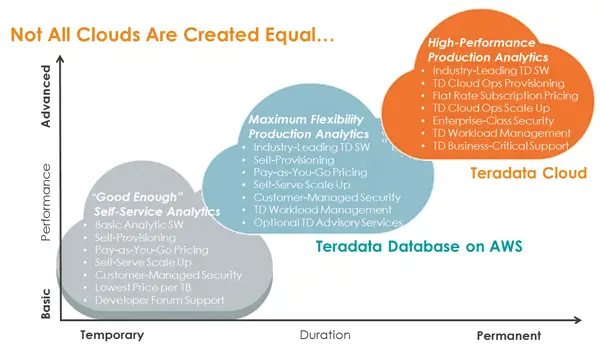 Unique, new types of datasets are forcing companies to investigate cloud-powered analytics to tap into data that can steer a company’s direction and its decision making. These datasets have challenging characteristics that require moving the analytics platform and not the data that should be mined.
Unique, new types of datasets are forcing companies to investigate cloud-powered analytics to tap into data that can steer a company’s direction and its decision making. These datasets have challenging characteristics that require moving the analytics platform and not the data that should be mined.
A few months ago, I was part of a briefing from Teradata, one of the largest data warehouse and analytics software vendors in the world. Teradata announced that they would be bringing their analytics platform to Amazon Web Services and offering their data platform on a utility based consumption model. But it wasn’t the announcement as much as the reason that I found really interesting on the call. According to Teradata, data proximity is one of the key driving factors to move analytics onto cloud platforms like Amazon’s.
Big Data has been an industry buzzword for several years, now. Working for a medium business, its occurred to me that big data and big data problems just were outside of my area of concern. We don’t have that much data, I thought, but I have realized I was wrong. You don’t have to be a big business to have big data problems and benefit from the analysis of big data sets. The rate at which data is being generated has exploded in the last couple years and it will continue to explode in years to come because of new innovation.
New datasets
First, there are massive amounts of data being generated online through social networks like Facebook, Twitter, Instagram and others. This data has the potential to provide insights into customer perception and concerns for any brand and company, if they can tap into the data and make sense of it.
Sensor data is another major area of concern. Enterprise has long had appliances with sensors that report back environmental conditions in data centers. Hardware vendors have built sensors into their servers and racks to report back hot-spots and cold-spots and look at optimal power usage and optimize operational costs. But the truth is that Internet of Things is bringing a massive expansion of sensor data. Everything from your toaster to light bulbs have sensors and data that can be tapped for different uses. Depending on the business and use cases, there are massive datasets created by these devices that may have use cases for the enterprise.
As another example, municipalities are increasingly deploying cameras throughout their territory to watch for accidents and gain visibility when crimes occur. Video takes an immense amount of storage and event more than just storing the data, making sense of that data once it is acquired is more than a human and manually perform. This requires an automated software method to analyze and make sense of the video data being transmitted.
A common trait
All three of these examples share one common trait. The data generated exists outside of the corporate firewall – the usual place where analytics platforms are run – and sometimes outside of the control of the enterprise – as is the case with Internet sites and sensor data from products sold to customers. This presents the idea of data proximity and locating the analytics platform closer to the data it should mine.
Data proximity is an interesting concept. Cloud services – like Twitter, Facebook and other social services – have created a ton of new data but it is not necessarily data that needs to be transported and stored within the confines of the corporate firewall. Datasets like video are far too large to be transported once they are at rest and this may also be a driving factor for locating the analytics closer to the dataset.
Teradata’s solution
The Teradata Database on AWS is the solution announced in October. Running on the Amazon Web Services, it offers customers a pay-as-you-go consumption model with self-provisioning services and scale up capabilities. It joins Teradata’s existing Teradata Cloud offering that is a dedicated analytics platform hosted by Teradata in its datacenters. While the Teradata Cloud is targeted at high-performance analytics, the Teradata Database on AWS is targeted at middle ground customers who need a reliable, production analytics platform with the economies of scale and pricing of utility cloud computing.
In addition to allowing the software to run on AWS, Teradata also announced optional advisory services to assist customers with the setup and configuration in AWS. The white-glove configuration allows customers a well-supported environment configured by professional with years of experience, rather than a do-it-yourself approach to getting your own analytics running in the cloud.

Teradata Database on AWS intends allow companies of all sizes to run a powerful analytics platform, locating it closer to the datasets it needs to investigate while enabling adoption with a more approachable cost.
